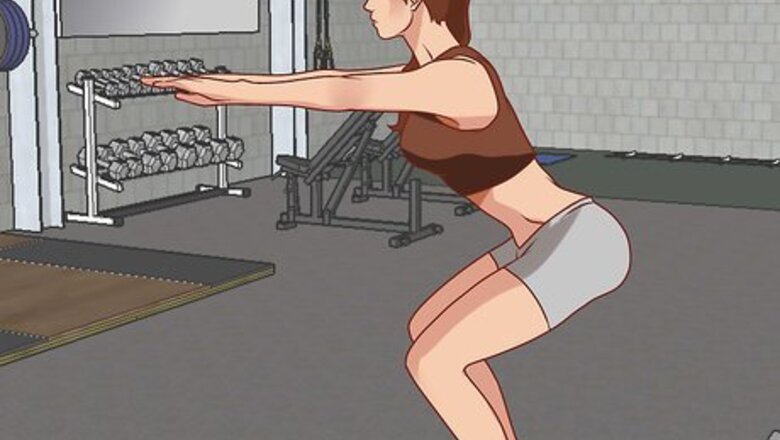
views
- With weights, perform lunges, squats, step-ups, and deadlifts to build your glute muscles.
- Without weights, try some calisthenics, bridges, leg raises, and running.
- To maintain a diet that supports muscle growth, go for well-balanced meals, healthy fats, and lots of water.
Working Out with Weights
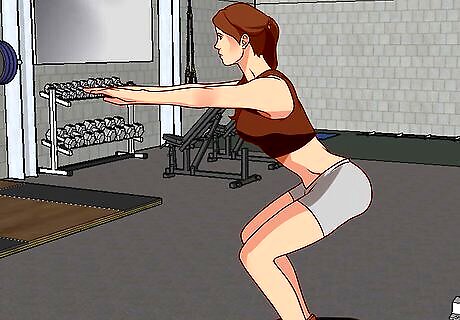
Squat regularly. You can't build a better butt by only focusing on squats, but you should still do them. Squats may be the most effective total lower body exercise you can do. Stand with your feet under your shoulders and slightly pointed outward. Keep your back straight and your eyes forward. If it helps, find a spot on the wall in front of you to focus on. Look at this spot throughout the entire squat. Breathe in and start bending at the hips while pushing your butt back. As your knees start to bend keep pushing your hips back. A proper squat should feel somewhat like sitting on your heels. Focus on keeping your knees lined up with your toes. To execute a proper squat, make sure your hip joint is lower than your knees. Once you feel comfortable squatting, try to go deeper than this for a more intense workout. Breathe out and drive your feet into the ground to bring yourself back up. Squeeze your glutes and push your hips forward until you're back to the starting position. If you're knew to lifting, try working with just the bar to get a feel for the form. You can even do squats with just your body weight. These are "air squats," and are an excellent way to warm up. Once you start adding weight, aim for an amount you can lift for 5 full "reps," or repetitions. Each time you squat and come back up is a full repetition.
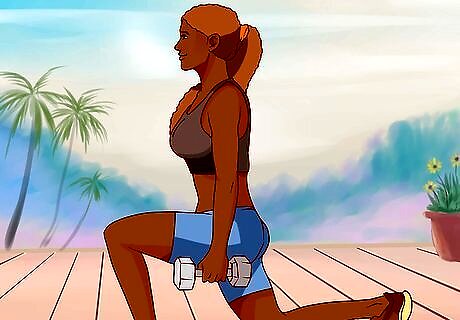
Do lunges with weights. As with squats, keep your back straight and find a spot in front of you to focus on. Relax your shoulders. Your feet should be about shoulder width apart. Find a comfortable weight to hold in each hand. Take a step forward with one leg until your knee is bent at a 90-degree angle. Keep this front knee in line with your ankle. The knee of your back leg should also be bent at a 90-degree angle. Do not let it touch the floor. Pushing off with the heel of your front leg, return to the starting position and repeat with the other leg. Try reverse lunges. Set up the basic starting position for lunges. Instead of taking a step forward, step backward. Keep your back straight as you would in a forward lunge. This requires a little more balance than the forward lunge. Make sure you're comfortable with your form before attempting a reverse lunge. Lunges are a good lower body exercise, but they can put a lot of strain on your knees. Take smaller steps if you feel pain in your knees. You can always work to increase your range of motion.
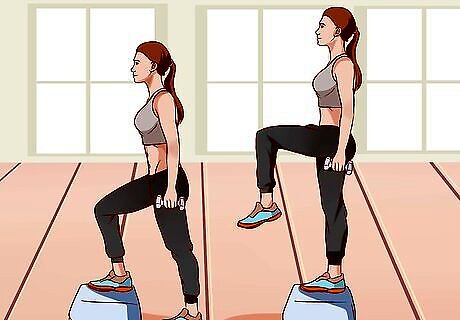
Do weighted step-ups. Find a small platform or step stool. Holding a dumbbell in each hand, and standing up straight, place one foot onto the platform. Pushing with your lead foot, lift the rest of your body onto the platform. As you lift the rest of your body onto the platform, breathe out. Place your lead leg back on the ground. Move your body off the platform until you are standing back in the starting position. As with lunges, you should alternate which leg you start each rep with.
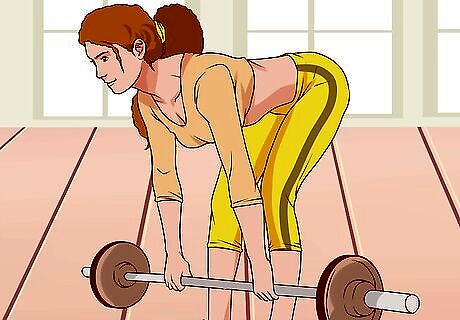
Try deadlifts. Deadlifts are a compound exercise. They will work out your lower body, but they also help with core and back strength. Stand up straight in front of a barbell with weights. Your feet should be under your shoulders and the bar should be over the middle of your feet. Keeping your back straight and your hips in place, lean down and grab the bar. Your hands should be a little further apart than your legs. Once you have a good grip on the bar, lower your hips and bend your knees slightly. To lift the weight off the ground, drive your feet down into the ground and pull up until you are standing upright. Inhale as you lift. Keep everything tight as you lift the weight off the ground. Squeeze your butt, engage your core, and don't lean back. Once you've lifted the weight off the ground, do not just drop the bar. To set the weight back down, reverse the movement you used to lift it. Keeping everything tight, push the hips back and begin bending the knees. Focus on a spot in front of you and move your entire body down at the same time. Do not lean forward and do not round your back.
Working Out without Weights
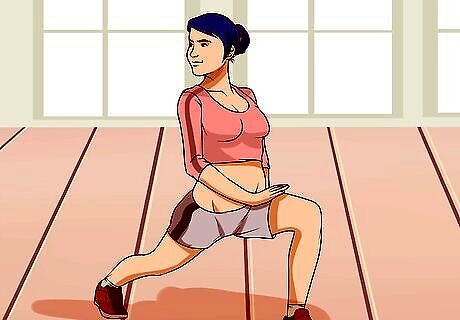
Add calisthenics to your routine. Some exercises that require weights can be done without weights. If you don't have time to hit the gym, you can do calisthenics almost anywhere. To do an air squat, set up as if you were in front of the squat rack at the gym. Put your feet a little more than shoulder width apart, with your toes facing outward. Using the same form you would in weighted squats, lower your hips and push your butt back. To help keep your balance, push your arms out in front of you as you lower down. Lunges can be performed without weights very easily. The form is exactly the same with or without weights. To do a glute kickback, set up as if you were going to do a push-up, but stay on your knees. Lift one leg off the ground until your thigh is parallel to the ground. Keep your shin perpendicular to the ground and push your leg up. Lower you leg slowly and repeat with the other leg.
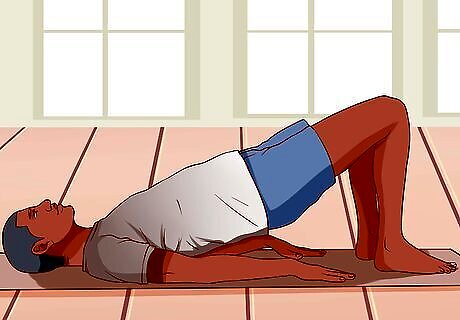
Try doing bridges. To do a short bridge, lie flat on your back with the bottoms of your feet on the floor and your knees at about 45 degrees. Keep your shoulders and arms on the floor. Push up using your heels and raise your hips up as high as possible. Hold at the top for two seconds. Slowly lower your body back to the ground. Once you've mastered the short bridge, try doing a straight bridge. The straight bridge is a lot like a reverse push up. Sitting up with your legs straight in front of you, place your hands near your hips. Push your torso up and squeeze your butt. Hold for a few seconds before lowering back down. To do a full bridge, lie flat on your back. Bend your knees and place your hands by your head. Lift your entire body off the ground and arch your back. Push your hips into the air and squeeze your legs, butt, and core. Take a deep breath and make sure you give everything a good stretch. Hold for a 1-2 seconds and then lower yourself back down.
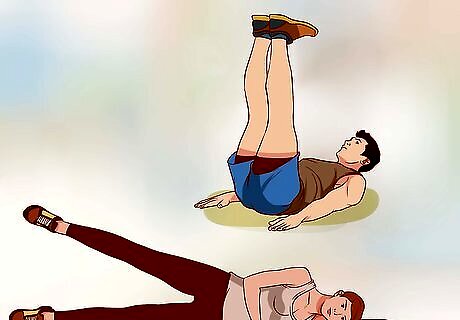
Do leg raises. Lie down on your side and rest your head on your bottom arm. Place your other arm palm down in front of you body. Keep both of your legs straight and lift your top leg about 1 foot off of your bottom leg. Lift your bottom leg to meet your top leg. Slowly lower both legs to the ground. Another variation is to lie flat on your back with your legs straight in front of you. Slowly lift your legs off the ground to a 90-degree angle. Hold for one second and then lower your legs taking care not to let them touch the ground.
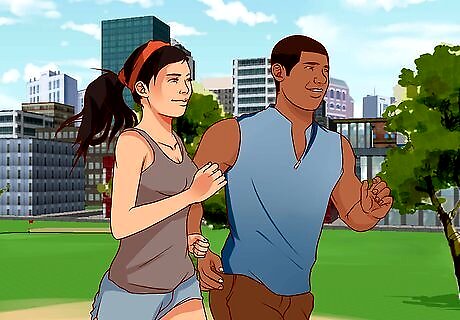
Go for a run. Running is a great way to tone your legs and butt. Any kind of running is likely to improve your lower body, but sprinting might be the best way. For an added challenge, run up a hill. Hill sprints will improve your glutes by putting more stress on your hip flexors. Running is a high impact activity and may not be good for your joints. If you can't run, try using an elliptical machine or a stationary bike.
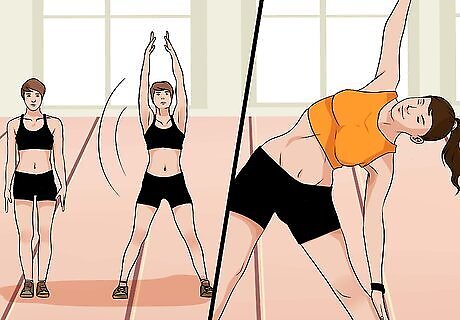
Experiment with other exercises. There are numerous exercises that workout your glutes and lower body. Do some research and find some new exercises to incorporate into your routine. Some people find that adding new exercises keeps them motivated to keep working out. Try out a hip thrust exercise for something a little different. You could also try joining a yoga class. Yoga is an excellent way to strengthen your muscles, increase flexibility, and tone your body. You can even change up your glute workout with exercise bands.
Maintaining a Proper Diet
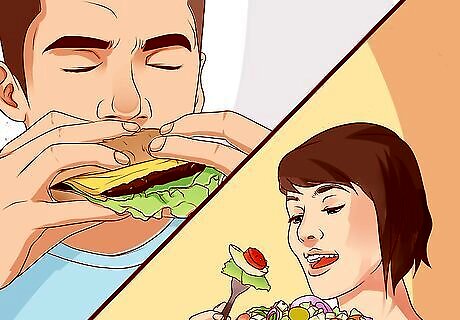
Watch what you eat. A large part of getting a better butt, and a better body in general, is diet. If you don't combine exercise with healthy eating, you won't get good results. To get the best results, calculate your recommended caloric intake. You need energy to work out. If you want to lose weight, consume fewer calories. If you want to gain weight, consume more. Either way, make sure you are balancing your work out with the amount of calories you consume.

Eat well-balanced meals. You need protein to gain muscle, but you need carbohydrates for energy. Don't focus too heavily on one or the other. To get the most out of your diet, make sure you know how much of each you need. About 15% of your daily caloric intake should come from protein, and about 55% should come from carbohydrates. Lean proteins, such as chicken and fish, are better for you than red meat. Incorporate a vegetarian meal two or three times a week to mix things up. Eat whole grains, sweet potatoes, and whole wheat breads for a good source of energy.

Eat the right kind of fat. You need a certain amount of healthy fats to maintain good health. Good fats are usually liquid at room temperature. Fats such as olive oil, flaxseed oil, and safflower oil are good. If a fat is solid at room temperature, such as butter, avoid it.
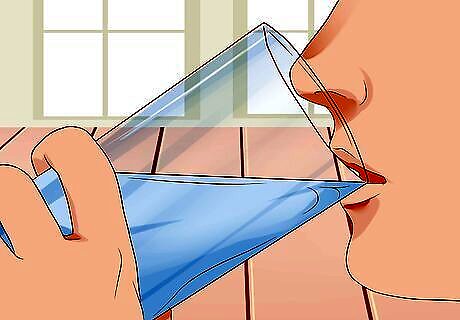
Drink plenty of water. Water is necessary to keep the body hydrated. Aim for a glass of water for every 20 minutes of exercise.
Understanding the Butt Muscles

Develop the right muscles. When searching for a way to build a better butt, keep in mind that there are three muscles that make up the butt. Consider each of these muscles when creating your workout plan. The gluteus maximus is the largest of the butt muscles, as well as the largest muscle in the body. When you rise from a squat position, or do any kind of thigh extension, this is the muscle you are using. The gluteus medius and the gluteus minimus have similar functions. When running, they stabilize your leg as it hits the ground. They also help with thigh rotations.
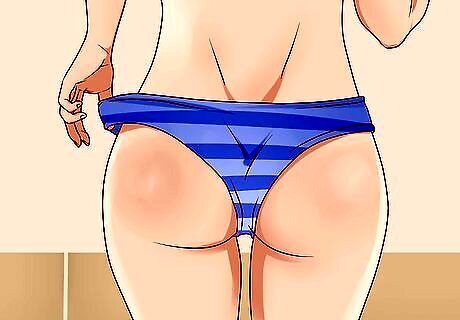
Discover your true shape. Don't focus too much on achieving a certain type of butt. As with the rest of your body, it is largely genetic. Whether you have a large set of glutes or a particularly small set is probably the result of heredity. You can still work your butt muscles and make them stronger, but you may not be able to change their shape.
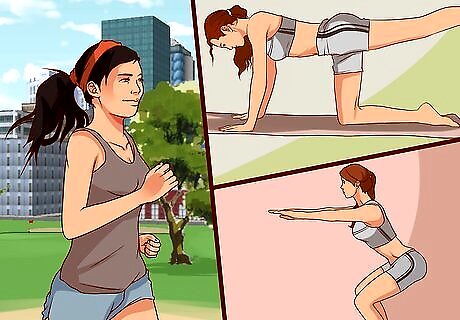
Mix it up. The best way to build a better butt is to workout all three muscles with a variety of exercises. Don't rely on just squats to get your butt in shape. The glutes respond to both strength and endurance training. Some of the muscles are "fast-twitch," meaning they respond to bursts of power. These muscles get worked out during exercises such as the squat. The glutes also contain "slow-twitch" muscles, which respond to aerobic exercises and running.



















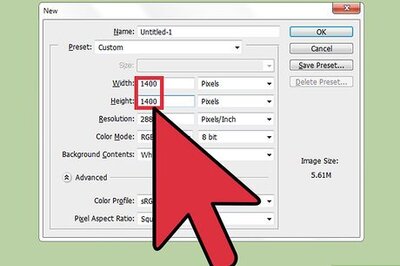
Comments
0 comment